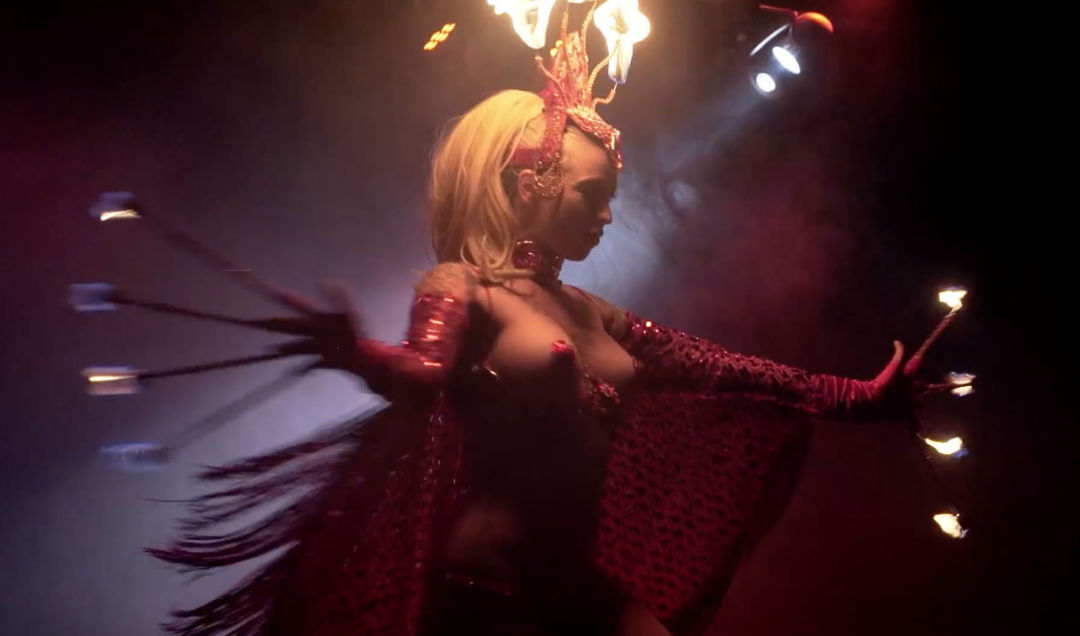A New Movie Brings Portland’s Star Burlesque Performers to the Big Screen

Image: XLRator Media
“Here’s to reveling in who we are and the ability to do what we do,” intones Portland performer Isaiah Esquire in a scene that opens Burlesque: Heart of the Glitter Tribe, a new movie by local filmmaker Jon Manning. What he does—what’s at the heart of this film—is burlesque, the art form documented through a troop of this city’s stars in the field, introduced to Manning seven years ago when he was taken to see a show by his wife, the film’s producer, Julie Livingston.
“Other than a cursory knowledge, I didn’t have any idea of what I was going to see except that it would probably be titillating and fun,” says Manning, for whom the movie was his feature-length directorial debut. “I was pretty much blown away. The amount of joy that these people had between themselves, and with the audience.”
Manning describes what he saw as part of a new wave of burlesque—a centuries-old tradition—that he discovered was thriving all over the country. “It’s not just in New Orleans and San Francisco and Portland and Seattle,” he says. “Try Cincinnati, Eugene, San Antonio, and East St. Louis.”
His exploration of the art form took him all over the US. “My wife and I were seeing shows around the country,” he says. Yet the people he kept coming back to were from Portland: celebrated local performers such as Esquire, Zora Von Pavonine, Angelique DeVil, and Babs Jamboree among them. “The people you see in the movie were the ones that rose to the surface, and then we realized that many of them had relationships together. We heard these words “glitter tribe,” and we realized that part of why they do this is for a chosen family.”
The film intersperses footage of these performers on stage—think pink feathers, centillions of sequins, fire juggling, tassles, assles, and a burrito costume that must be seen to be believed—with candid interviews in which the performers explore their attraction to the form and their personal interpretations of its possibilities.
“[Angelique DeVil] is an amplification of all the people that I’ve been, that I am, that I wanna be,” says one performer of her onstage persona. “She is that five-year-old who ran around making silly faces, doing whatever she had to to make you laugh. She is that brooding, tragic teenager who wants you to see her black soul.”
We see them with family members, in their homes, at their day jobs, and mid-transformation as they take part in the painstaking process of becoming their stage selves.
“I don’t consider myself a drag queen. I’m a character impersonator,” says Esquire. For him, the look must reflect the character he is embodying and the dance is the animating force. “The character comes alive in the movement. When I’m in the heels, I can move this way. As soon as my five minutes are up, I am back to Isaiah.”
For Manning, the movie—one he describes as “a DIY, Oregon film,” employing over 200 locals over its seven-year gestation, and financed by the director and his partner—is not so much a paean to the city in which it takes place as a tribute to the performers and their art.
Yet he was wary of wading into a subculture to which he doesn’t personally belong. “I wanted to be aware of the things I didn’t know,” he says. “I wanted from the very beginning to make sure that my partner, who is a woman, and the producers, all women, and the editors, all women, were going to ensure I wasn’t going to make something that was about the male gaze. I wanted it to be as feminist-forward as my experience of burlesque as a whole.”
That's because burlesque, Manning says, can be feminist, adding that he would use that word to describe every single person he interviewed for the film.
“These are people that love women for something other than their bosoms or what they represent sexually, and they keep those women safe, and they believe they have a voice and that what they want to do they should be allowed to do, and they get to do what they want with their bodies,” he says. “That’s empowering to me as a filmmaker and an audience member.”
The film, which opened in 22 cities last week through the New York Film Critics National Series, opens on Friday, March 3, at Portland’s Living Room Theaters. For Manning, the goal is as wide an audience as possible, for its weeklong local run and its afterlife on iTunes and Amazon.
“The film is about empathy,” he says. “People have asked what my wish is for the film, and it’s that the most people see it as possible and that it might expand their empathy to subcultures, or groups of people that they have biases about, that they don’t know anything about or think they know something about.” He pauses. “And that you might be less lonely for 76 minutes.”
Burlesque Heart of the Glitter Tribe from Brightwater Media on Vimeo.
Burlesque: Heart of the Glitter Tribe opens at Living Room Theaters on Friday, March 3.




